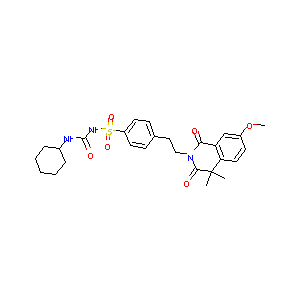Details of the Drug
General Information of Drug (ID: DMB0EUX)
| Drug Name |
Gliquidone
|
||||||||||||||||||||||
|---|---|---|---|---|---|---|---|---|---|---|---|---|---|---|---|---|---|---|---|---|---|---|---|
| Synonyms |
Beglynor; Beglynora; Glikvidon; Gliquidona; Gliquidonum; Glurenorm; Glycvidon; ARDF 26; ARDF 26 SE; AR-DF 26; Gliquidona [INN-Spanish]; Gliquidone (INN); Gliquidone [BAN:INN]; Gliquidonum [INN-Latin]; Glurenorm (TN); N-[(cyclohexylamino)carbonyl]-4-{2-[4,4-dimethyl-7-(methyloxy)-1,3-dioxo-3,4-dihydroisoquinolin-2(1H)-yl]ethyl}benzenesulfonamide; 1-Cyclohexyl-3-((p-(2-(3,4-dihydro-7-methoxy-4,4-dimethyl-1,3-dioxo-2(1H)-isoquinolyl)ethyl)phenyl)sulfonyl)urea; 1-Cyclohexyl-3-(p-beta-(4,4-dimethyl-2-methoxy-1,3-(2H,4H)-isoquinolinedione-2-yl)phenethyl)sulfonylurea; 1-cyclohexyl-3-(p-beta-(4,4-dimethyl-2-methoxy-1,3-(2H,4H)-isoquinolinedione-2-yl)phenethyl)sulfonylurea; 1-cyclohexyl-3-[4-[2-(7-methoxy-4,4-dimethyl-1,3-dioxoisoquinolin-2-yl)ethyl]phenyl]sulfonylurea
|
||||||||||||||||||||||
| Indication |
|
||||||||||||||||||||||
| Therapeutic Class |
Hypoglycemic Agents
|
||||||||||||||||||||||
| Drug Type |
Small molecular drug
|
||||||||||||||||||||||
| Structure |
 |
||||||||||||||||||||||
| 3D MOL | 2D MOL | ||||||||||||||||||||||
| #Ro5 Violations (Lipinski): 1 | Molecular Weight (mw) | 527.6 | |||||||||||||||||||||
| Logarithm of the Partition Coefficient (xlogp) | 4.6 | ||||||||||||||||||||||
| Rotatable Bond Count (rotbonds) | 7 | ||||||||||||||||||||||
| Hydrogen Bond Donor Count (hbonddonor) | 2 | ||||||||||||||||||||||
| Hydrogen Bond Acceptor Count (hbondacc) | 6 | ||||||||||||||||||||||
| ADMET Property |
|
||||||||||||||||||||||
| Chemical Identifiers |
|
||||||||||||||||||||||
| Cross-matching ID | |||||||||||||||||||||||
Molecular Interaction Atlas of This Drug
 Drug Therapeutic Target (DTT) |
|
|||||||||||||||||||||||||||||||||||||||||
|---|---|---|---|---|---|---|---|---|---|---|---|---|---|---|---|---|---|---|---|---|---|---|---|---|---|---|---|---|---|---|---|---|---|---|---|---|---|---|---|---|---|---|
 Drug-Metabolizing Enzyme (DME) |
|
|||||||||||||||||||||||||||||||||||||||||
 Drug Off-Target (DOT) |
|
|||||||||||||||||||||||||||||||||||||||||
| Molecular Interaction Atlas (MIA) | ||||||||||||||||||||||||||||||||||||||||||
References
